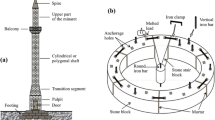Abstract
Historical minarets are quite sensitive structures against horizontal loads as they are tall, slender and masonry constructions. Due to their special characters, significant damages are occurred in critical part by devastating earthquakes. These damages lead to more comprehensive studying about minarets. In this study; the effect of geometrical features was investigated for dynamic behavior of seven historical masonry minarets in Bursa. However, dynamic character identification of historical masonry minarets are so difficult. Therefore, ambient vibration test were performed with aim of defining modal parameters of the minarets. Since the structural behavior of historical minarets were also represented with mathematical models, three dimensional (solid) models were implemented by using the finite element software Abaqus Cae. Model updating was performed in order to match the natural frequencies arising from the experimental investigation with those from numerical results. According to the results obtained from both forms, effect of geometric features on the dynamic behavior of minarets was evaluated. The relationships are between the first mode period of the minarets and the structural properties such as height, cross section, boundary condition. Then, the analytical formula was derived from the relationships for rapid estimation of the fundamental period of the typical Ottoman minarets. Finally, it was found that the period of the minarets from the formula close enough to modal test and modal analysis results.
Similar content being viewed by others
References
Abaqus/CAE 6.9 (2009). Abaqus user manual, Rising Sun Mills, 166 Valley Street, Providence, RI02909-2499.
Abdel-Motaal, M. A. (2014). “Effect of piles on the seismic response of mosques minarets.” Ain Shams Engineering Journal, Vol. 5, No. 1, pp. 29–40.
Bağtürk, M. H. (2013). Investigation of dynamic behavior of historical masonry minarets with modal analysis method in Bursa, MSc Thesis, Graduate School of Natural and Applied Sciences, Turkey. (in Turkish).
Clementa, P, Saitta, F., Buflarini, G., and Platania, L. (2014). Stability and seismic analyses of leaning towers: The case of the minaret in Jam, The Structural Design of Tall and Special Buildings, DOI: 10.1002/tal.1153.
Doğangün, A., Acar, R., Sezen, H., and Livaoğlu, R. (2008). “Investigation of dynamic response of masonry minaret structures.” Bulletin of Earthquake Engineering, Vol. 6, pp. 505–517, DOI: 10.1007/s10518-008-9066-5.
Ertek, E. and Fahjan, Y. (2007). Structural systems of ottoman minarets: Classification, modelling and analysis, 6 th National Earthquake Engineering Conference, December, 16-20 Ekim, stanbul, Turkey.
Kuban, D. (1974). Muslim Religious Architecture -Part I, Leiden, E. J. Brill, Netherlands.
Oliveira, C. S., Çaktğ, E., Stengel, D., and Branco, M. (2012). “Minaret behavior under earthquake loading: The case of historical stanbul.” Engineering and Structural Dynamics, Vol. 41, pp. 19–39, DOI: 10.1002/eqe.1115.
Peña, Fernando, Paulo B. Lourenço, Nuno Mendes, and Daniel V. Oliveira (2010). “Numerical models for the seismic assessment of an old masonry tower.” Engineering Structures, Vol. 32, No. 5, pp. 1466–1478.
SAW (1964). Towers of Islam, Saudi Aramco World. March/April:18-21 (http://www.saudiaramcoworld.com/issue/196402/towers.of. islam.htm) Sayar, Z. (1977). Does minaret lose its task? Arkitekt, No. 368, pp. 154–157. (in Turkish)
Sezen, H., Acar, R., Doğangün, A., and Livaoğlu, R. (2008). “Dynamic analyses and seismic performances of reinforced concrete minarets.” Engineering Structures, Vol. 30, pp. 2253–2264, DOI: 10.1016/j.engstruct.2007.11.005.
SignalCalc 240 (1997). ACE Dynamic Signal Analyzer, User Manual, Data Physics Cooperation.
Tuluk, Ö. I, Dogangün, A., Livaoglu, R., and Acar, R. (2006). “Traditional Turkish minarets on the structural system and architectural aspects.” Journal of Yap Dünyas, Turkey, No. 122, pp. 41–49 (in Turkish).
Turk, A. M. (2013). Seismic response analysis of masonry minaret and possible strengthening by Fiber Reinforced Cementitious Matrix (FRCM) materials, Advances in Materials Science and Engineering, art. No. 952497.
Ödekan, A. (1977). Minaret, Eczac ba art encyclopedia, Vol: 2, stanbul, Turkey, pp. 1259. (in Turkish)
Author information
Authors and Affiliations
Corresponding author
Rights and permissions
About this article
Cite this article
Livaoğlu, R., Baştürk, M.H., Doğangün, A. et al. Effect of geometric properties on dynamic behavior of historic masonry minaret. KSCE J Civ Eng 20, 2392–2402 (2016). https://doi.org/10.1007/s12205-016-0622-2
Received:
Accepted:
Published:
Issue Date:
DOI: https://doi.org/10.1007/s12205-016-0622-2




